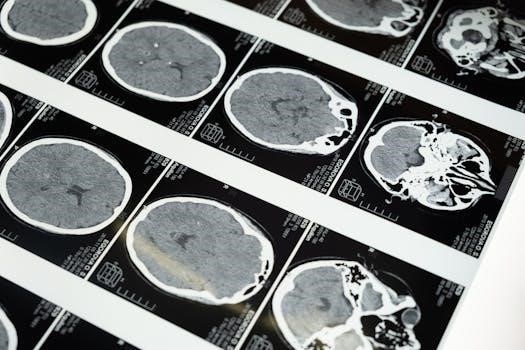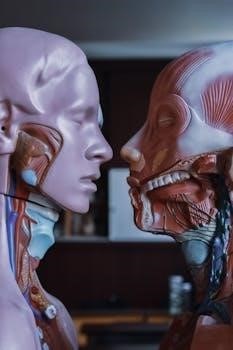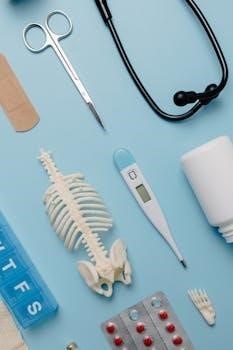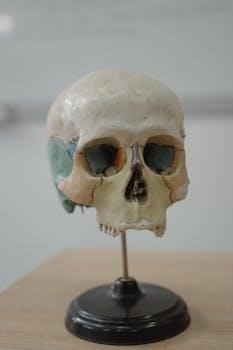
laboratory manual for anatomy and physiology
Lab manuals are essential tools in the study of human anatomy and physiology‚ providing structured activities. These manuals guide practical exercises‚ supplementing theoretical knowledge gained from textbooks and lectures. They enable hands-on learning‚ enhancing understanding of the subject.
Purpose of Lab Manuals in A&P
The primary purpose of anatomy and physiology (A&P) lab manuals is to facilitate practical application of theoretical concepts. They serve as a roadmap for laboratory sessions‚ guiding students through experiments‚ dissections‚ and observations. Lab manuals provide a structured framework for learning‚ ensuring students engage with the material in an organized manner. They offer detailed instructions‚ safety protocols‚ and data recording methods‚ promoting accurate experimentation. Additionally‚ lab manuals aim to enhance critical thinking skills through analyzing results and drawing conclusions. They bridge the gap between textbook knowledge and real-world understanding of the body’s structure and function. Furthermore‚ these manuals reinforce learning through active participation‚ allowing students to visualize and manipulate anatomical specimens and physiological processes. Ultimately‚ lab manuals are crucial for developing essential laboratory techniques and scientific reasoning abilities within the study of A&P. They provide a hands-on approach‚ vital for thorough comprehension and retention of complex biological systems.
Key Components of a Typical Lab Manual
A typical anatomy and physiology (A&P) lab manual contains several essential components designed to facilitate effective learning. Firstly‚ it includes a detailed introduction to each experiment or activity‚ providing necessary background information and learning objectives. Secondly‚ clear and concise procedural instructions guide students through each step of the experiment‚ ensuring safety and accuracy. Thirdly‚ lab manuals often feature pre-lab exercises or quizzes to assess prior knowledge and prepare students for the upcoming session. Fourthly‚ they provide space for data recording‚ observations‚ and calculations‚ fostering scientific documentation skills. Fifthly‚ post-lab questions prompt students to analyze results‚ draw conclusions‚ and relate findings to theoretical concepts. Sixthly‚ the inclusion of diagrams‚ illustrations‚ and photographs aids in visualizing anatomical structures. Finally‚ many lab manuals incorporate safety guidelines‚ emphasizing the importance of safe laboratory practices. These components ensure that lab manuals are comprehensive tools for practical learning in A&P‚ enhancing both understanding and practical skills. They are vital for a well-structured and effective lab experience.

Fundamental Concepts in A&P Lab
In A&P labs‚ understanding fundamental concepts is crucial. This includes mastering microscopy techniques to observe cellular structures‚ and identifying basic tissues such as epithelial‚ connective‚ muscle‚ and nervous tissue. These form the foundation.
Microscopy and Cellular Structures
Microscopy forms a cornerstone of any anatomy and physiology laboratory experience‚ enabling students to visualize the minute structures of cells and tissues. The lab manual will guide users through the proper use of compound light microscopes‚ including illumination techniques‚ focusing‚ and magnification adjustments. Students will learn to prepare wet mount slides of various specimens‚ observing cell shapes‚ sizes‚ and internal components such as the nucleus‚ cytoplasm‚ and organelles. Through microscopy‚ students will be able to differentiate between prokaryotic and eukaryotic cells‚ as well as specialized cells within multicellular organisms. Detailed exercises will involve identifying cell types based on their unique characteristics and learning how to estimate cell dimensions using micrometers. Students will also learn to recognize common artifacts that may be present in slides and how to distinguish them from actual cell structures. The manual will also cover basic staining techniques that enhance contrast and improve visualization of cellular components‚ making the study of cellular structures more effective.
Basic Tissues⁚ Epithelial‚ Connective‚ Muscle‚ Nervous
The lab manual provides a comprehensive exploration of the four basic tissue types⁚ epithelial‚ connective‚ muscle‚ and nervous. Students will learn to identify each tissue type based on its unique structure and function through microscopic observation. Epithelial tissues‚ characterized by their cellular organization and role in lining and covering surfaces‚ will be examined through various examples‚ including squamous‚ cuboidal‚ and columnar cells. Connective tissues‚ which support and bind other tissues‚ will be explored using slides of cartilage‚ bone‚ and blood. Muscle tissues‚ responsible for movement‚ will be observed in their three forms⁚ skeletal‚ smooth‚ and cardiac‚ noting their distinct cellular characteristics. Finally‚ nervous tissue‚ which transmits electrical signals‚ will be examined through slides of neurons and glial cells. Students will learn how the structure of each tissue type relates to its specific function within the body. The manual will emphasize practical identification skills and the importance of tissue organization in overall organ structure and function.

Systems-Based Approach in the Lab
This section of the lab manual shifts to a systems-based approach. It examines how different organs work together to perform specific functions. This includes exploring the skeletal‚ muscular‚ and other key systems.
Skeletal System⁚ Bones‚ Joints‚ and Articulations
This section of the laboratory manual delves into the intricacies of the skeletal system‚ a fundamental framework supporting the human body. The manual will guide students through the identification of various bones‚ emphasizing their unique shapes and functions. Exercises will focus on locating key anatomical landmarks on skeletal models and real specimens where available‚ using materials such as those found in ‘applied anatomy & physiology⁚ print workbook and lab manual’. Students will explore the different types of joints‚ examining how they facilitate movement. This will include analyzing the structures of synovial joints‚ cartilaginous joints‚ and fibrous joints. The articulation process‚ where bones connect‚ will be studied‚ with a focus on the range of motion and stability provided by different joint types. The lab exercises aim to make the student familiar with the skeletal system‚ going beyond mere memorization‚ using resources like ‘Human Anatomy Lab Manual’ to develop a deep understanding of the skeletal system.
Muscular System⁚ Muscle Identification and Function
This section of the lab manual focuses on the muscular system‚ crucial for movement‚ posture‚ and bodily functions. Students will learn to identify major skeletal muscles‚ examining their origins‚ insertions‚ and actions. Lab activities will involve using anatomical models and diagrams‚ along with resources similar to ‘Muscles Anatomy & Physiology Health Fitness Training Muscle Leg’‚ to locate and name muscles. The manual will guide students in understanding muscle function‚ exploring how muscles work in groups to produce specific movements. Students will investigate how muscles contract and relax‚ and the role of different muscle fibers. Practical exercises will include palpating muscles on the body and analyzing how muscle actions affect joint movements. This section will not just cover muscle names but also how muscles function‚ using hands-on techniques. The lab will go beyond the information in ‘Duke Anatomy ‒ Lab 2 Pre-Lab Exercise’‚ promoting a deeper understanding of muscle physiology and their roles in various bodily functions.

Physiological Experiments and Procedures
This section details hands-on experiments exploring physiological processes. Students will conduct experiments‚ gathering data on various systems. These practical activities aim to reinforce theoretical concepts‚ by providing real-world observation and analysis of human function.
Nervous System⁚ Reflexes and Nerve Conduction
This section of the lab manual delves into the fascinating world of the nervous system‚ focusing specifically on reflexes and nerve conduction. Students will engage in experiments designed to demonstrate the speed and mechanisms of nerve impulse transmission‚ a fundamental process for all bodily functions. Through carefully structured activities‚ learners will investigate the components of a reflex arc‚ observing the role of sensory receptors‚ afferent neurons‚ the central nervous system‚ efferent neurons‚ and effectors in generating responses. These experiments will utilize simple tools to measure reaction times‚ providing tangible evidence of neuronal pathways. Furthermore‚ the laboratory setting will allow for the examination of various factors affecting reflex speed‚ including stimulus intensity and the involvement of different types of neurons. By participating in these investigations‚ students will gain a deeper understanding of how the nervous system facilitates rapid communication throughout the body‚ enabling quick responses to stimuli and maintaining homeostasis. This section aims to bridge the gap between theoretical knowledge and practical application‚ reinforcing the critical importance of nerve conduction and reflex pathways in human physiology. The practicals will enhance the students’ comprehension of the complex interactions within the nervous system.
Cardiovascular System⁚ Blood Pressure and Heart Rate
This section of the lab manual provides practical experience in measuring and understanding key cardiovascular parameters⁚ blood pressure and heart rate. Students will learn to use a sphygmomanometer and stethoscope to measure systolic and diastolic blood pressure accurately‚ gaining hands-on experience with essential clinical techniques. Furthermore‚ students will investigate the factors that can influence blood pressure and heart rate‚ such as physical activity‚ posture‚ and stress. Experimental protocols will involve measuring these vital signs before‚ during‚ and after various activities‚ allowing students to observe the body’s dynamic response to different conditions. Data collected will be analyzed‚ providing a real-world context to the theoretical concepts learned in lectures. The lab will also explore the physiological mechanisms that regulate blood pressure and heart rate‚ linking them to the autonomic nervous system and hormonal control. Through these investigations‚ students will develop a deeper appreciation for the complex interactions within the cardiovascular system and its role in maintaining overall health. This hands-on approach will reinforce theoretical knowledge and provide valuable skills applicable in various healthcare settings. Practical exercises will allow students to see the immediate effects of various stimuli on the cardiovascular system.

Practical Applications and Assessments
This section bridges theory and practice‚ applying A&P concepts to real-world scenarios. It emphasizes practical skills and assesses understanding through hands-on activities and analytical evaluations. Clinical relevance is highlighted.
Respiratory System⁚ Lung Volumes and Capacities
This section of the lab manual focuses on exploring the mechanics of the respiratory system‚ specifically examining lung volumes and capacities. Students will engage in experiments designed to measure various lung volumes‚ such as tidal volume‚ inspiratory reserve volume‚ and expiratory reserve volume. These measurements will be obtained using spirometry‚ a common technique in respiratory physiology. Furthermore‚ students will calculate lung capacities‚ including vital capacity‚ total lung capacity‚ and functional residual capacity‚ by combining different lung volumes. The practical exercises in this section will allow students to understand how these parameters relate to respiratory health. By actively participating in these experiments‚ students will be able to correlate theoretical knowledge with experimental data. The lab manual will include clear instructions‚ diagrams‚ and data analysis guidance‚ facilitating a comprehensive understanding of respiratory mechanics. Students will analyze the results of their experiments‚ discussing factors that may affect these measurements‚ such as age‚ sex‚ and physical condition. This section also reinforces the clinical significance of these parameters in the diagnosis and management of respiratory diseases.
Digestive System⁚ Enzyme Activity
This part of the lab manual delves into the fascinating world of digestive enzymes and their roles in breaking down food. The experiments will focus on observing the activity of key enzymes‚ such as amylase‚ protease‚ and lipase. Students will conduct tests to understand how factors like temperature and pH affect enzyme activity‚ mimicking conditions in the digestive tract. The manual will guide students through the process of identifying the optimal conditions for each enzyme‚ emphasizing the importance of these factors in digestion. Laboratory exercises will include the use of substrates and indicators to visually determine enzyme activity. Students will learn to analyze data‚ drawing conclusions about how various enzymes facilitate the breakdown of food. Practical work will illustrate the specificity of enzymes‚ with different enzymes acting on specific substrates. This section provides a fundamental understanding of the chemical reactions essential for nutrient absorption. The manual also includes questions to encourage critical thinking about enzyme deficiencies and related digestive disorders. By the end of this section‚ students will grasp the vital function of enzymes in maintaining digestive health.
Review and Integration of A&P Concepts
This culminating section of the lab manual focuses on the review and integration of key anatomical and physiological concepts covered throughout the course. The aim is to foster a comprehensive understanding of how different body systems work together to maintain homeostasis. Students will participate in review activities‚ including case studies and practical scenarios that require them to apply their accumulated knowledge. This section will encourage students to connect the dots between the microscopic structures studied in earlier labs and the complex functions of the whole organism. The manual will include exercises that promote analytical thinking‚ asking students to predict the physiological consequences of anatomical disruptions. Interactive sessions may involve group discussions‚ promoting collaborative learning. Students are expected to synthesize information from various sections of the manual‚ thus reinforcing their comprehension of A&P principles. Emphasis will be placed on understanding the interdependencies of bodily systems. This section also serves as a platform for students to revisit challenging concepts and clarify any remaining doubts. The manual provides tools for effective self-assessment‚ ensuring students are well-prepared for final evaluations. Ultimately‚ this section will provide a holistic view of human anatomy and physiology.